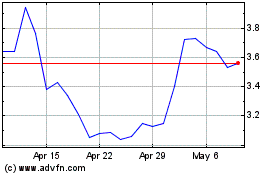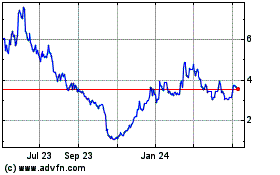OMIDRIA® Added to Veterans Health Administration National Formulary
April 12 2018 - 9:10AM
Business Wire
-- OMIDRIA now available across the VA
system to benefit U.S. veterans --
Omeros Corporation (Nasdaq: OMER) today announced that the
Veterans Administration (VA) has added OMIDRIA® (phenylephrine and
ketorolac intraocular solution 1% / 0.3%) to the VA National
Formulary. The VA National Formulary is a listing of drugs and
supplies that must be available at all VA facilities for the
benefit of U.S. military veterans. Omeros’ commercial drug
OMIDRIA is the first and only FDA-approved product to maintain
pupil size by preventing intraoperative miosis and to reduce
postoperative pain associated with cataract or lens replacement
surgery. It is estimated that approximately 65,000 to 80,000
cataract surgery procedures will be performed in the VA system in
2018. Over 90 percent of all U.S. medical schools are affiliated
with a VA facility. The VA conducts the largest education and
training effort for health professionals in the nation with nearly
all U.S.-trained physicians receiving some or all of their training
in the VA system.
The decision to add OMIDRIA to the VA formulary was made
following review of the expanding set of efficacy and safety data
for OMIDRIA, including publications in peer-reviewed journals
documenting a number of the drug’s clinical benefits such as fewer
surgical complications, reduced need for iris-damaging
pupil-expansion devices, less postoperative pain and better
surgical outcomes. As a result of its addition to the formulary,
the drug is available to ophthalmic surgeons in all VA facilities,
effective immediately. The initial recommendation is that use of
OMIDRIA be limited to high-risk patients at the discretion of VA
ophthalmic surgeons. Examples of high-risk patients include
those with a history of using an alpha-1-antagonist (e.g.,
Flomax®), panretinal photocoagulation, eye trauma,
pseudoexfoliation, peripheral iridotomy, pilocarpine use, or those
who have a dense lens or will be receiving a toric intraocular lens
(IOL). Given the demographics of cataract surgery patients within
the VA system, many of these risk factors are common.
“We are pleased that the VA is allowing veterans access to
OMIDRIA, and we appreciate the opportunity to participate in their
care,” said Gregory A. Demopulos, M.D., chairman and chief
executive officer of Omeros. “The VA is committed to providing
high-quality medical treatments as evidenced by the use of
innovative technologies in cataract surgery, including multifocal
IOLs, femtosecond lasers and, now, OMIDRIA. We also look forward to
contributing to the training of ophthalmic surgery residents,
allowing them to experience first-hand the benefits of
OMIDRIA.”
OMIDRIA, together with a small group of other drugs, received a
two-year extension of pass-through status as part of the recently
enacted omnibus bill. Designed to promote innovation, pass-through
status provides for separate payment (i.e., outside of the packaged
reimbursement) by the Centers for Medicare and Medicaid Services
(CMS), allowing Medicare Part B beneficiaries to access the drug.
Separate and distinct from CMS’ pass-through and other
reimbursement, facilities within the Veterans Healthcare
Administration – America’s largest integrated health care system –
purchase OMIDRIA directly through Omeros’ existing wholesaler
channel.
About Omeros Corporation
Omeros is a commercial-stage biopharmaceutical company committed
to discovering, developing and commercializing small-molecule and
protein therapeutics for large-market as well as orphan indications
targeting inflammation, complement-mediated diseases and disorders
of the central nervous system. The company’s drug product OMIDRIA®
(phenylephrine and ketorolac intraocular solution) 1% / 0.3% is
marketed for use during cataract surgery or intraocular lens (IOL)
replacement to maintain pupil size by preventing intraoperative
miosis (pupil constriction) and to reduce postoperative ocular
pain. In the European Union, the European Commission has approved
OMIDRIA for use in cataract surgery and other IOL replacement
procedures to maintain mydriasis (pupil dilation), prevent miosis
(pupil constriction), and to reduce postoperative eye pain. Omeros
has multiple Phase 3 and Phase 2 clinical-stage development
programs focused on: complement-associated thrombotic
microangiopathies; complement-mediated glomerulonephropathies;
Huntington’s disease and cognitive impairment; and addictive and
compulsive disorders. In addition, Omeros has a diverse group of
preclinical programs and a proprietary G protein-coupled receptor
(GPCR) platform through which it controls 54 new GPCR drug targets
and corresponding compounds, a number of which are in preclinical
development. The company also exclusively possesses a novel
antibody-generating platform.
Forward-Looking Statements
This press release contains forward-looking statements within
the meaning of Section 27A of the Securities Act of 1933 and
Section 21E of the Securities Exchange Act of 1934, which are
subject to the “safe harbor” created by those sections for such
statements. All statements other than statements of historical fact
are forward-looking statements, which are often indicated by terms
such as “anticipate,” “believe,” “could,” “estimate,” “expect,”
“goal,” “intend,” “likely,” “look forward to,” “may,” “plan,”
“potential,” “predict,” “project,” “should,” “will,” “would” and
similar expressions and variations thereof. Forward-looking
statements are based on management’s beliefs and assumptions and on
information available to management only as of the date of this
press release. Omeros’ actual results could differ materially from
those anticipated in these forward-looking statements for many
reasons, including, without limitation, risks associated with
product commercialization and commercial operations, unproven
preclinical and clinical development activities, regulatory
oversight, intellectual property claims, competitive developments,
litigation, and the risks, uncertainties and other factors
described under the heading “Risk Factors” in the company’s Annual
Report on Form 10-K filed with the Securities and Exchange
Commission on March 1, 2018. Given these risks, uncertainties and
other factors, you should not place undue reliance on these
forward-looking statements, and the company assumes no obligation
to update these forward-looking statements, even if new information
becomes available in the future.
View source
version on businesswire.com: https://www.businesswire.com/news/home/20180412005509/en/
Cook Williams Communications, Inc.Jennifer Cook WilliamsInvestor
and Media Relations360.668.3701jennifer@cwcomm.org
Omeros (NASDAQ:OMER)
Historical Stock Chart
From Mar 2024 to Apr 2024

Omeros (NASDAQ:OMER)
Historical Stock Chart
From Apr 2023 to Apr 2024
